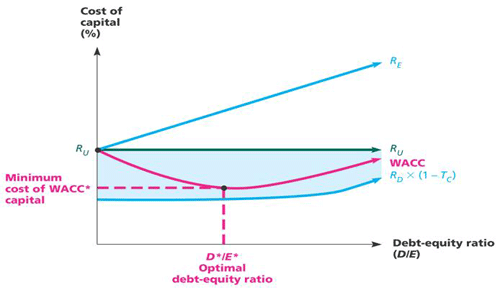Weighted Average Cost of Capital (WACC)
Post on: 20 Апрель, 2015 No Comment

A company has different sources of finance, namely common stock, retained earnings, preferred stock and debt. Weighted average cost of capital (WACC) is the average after tax cost of all the sources. It is calculated by multiplying the cost of each source of finance by the relevant weight and summing the products up.
Formula
For a company which has two sources of finance, namely equity and debt, WACC is calculated using the following formula:
Cost of equity is calculated using different models for example dividend growth model and capital asset pricing model.
Cost of debt is based on the yield to maturity of the relevant instruments. If no yield to maturity can be calculated we can base the estimate on the instrument’s current yield, etc.
The weights are based on the target market values of the relevant components. But if no market values are available we base the weights on book values.
Example
Company has a 1 million shares of common stock currently trading at $30 per share. Current risk free rate is 4%, market risk premium is 8% and the company has a beta of 1.2.
It also has 50,000 bonds with of $1,000 par paying 10% coupon annually maturing in 20 years currently trading at $950.
The tax rate is 30%. Calculate the weighted average cost of capital.
Solution:
First we need to calculate the weights of debt and equity.
Market Value of Equity = 1,000,000 $30 = $30,000,000
Market Value of Debt = 50,000 $950 = $47,500,000
Total Market Value of Debt and Equity = $77,500,000
Weight of Equity = $30,000,000 / $77,500,000 = 38.71%
Weight of Debt = $47,500,000 / $77,500,000 = 61.29%

Weight of Debt can be calculated as 100% minus cost of equity = 100% 38.71% = 61.29%
Second step in our solution is to calculate the cost of equity. With the given data we can use capital asset pricing model (CAPM) to calculate cost of equity as follows:
Cost of Equity = Risk Free Eate + Beta Market Risk Premium = 4% + 1.2 8% = 13.6%
We also, need to find the cost of debt. Cost of debt is equal to the yield to maturity of the bonds. With the given data, we can find that yield to maturity is 10.61%.
After tax cost of debt is hence 10.61% ( 1 30% ) = 7.427%
And finally,
WACC = 38.71% 13.6% + 61.29% 7.427% = 9.8166%
Uses of WACC
Weighted average cost of capital is used in discounting cash flows for calculation of NPV and other valuations for investment analysis.
WACC represents the average risk faced by the organization. It would require an upward adjustment if it has to be used to calculate NPV of project which are more risk than the company’s average projects and a downward adjustment in case of less risky projects.














